Below can be found an alphabetical list of the 48 constellations (including the 12 zodiacal constellations) that were known to the Greeks by the time of Ptolemy (c. 100 – c. 170 CE). All but one of them (Corona Australis) were also known to Hipparchos (c. 190 – c. 120 BCE) and all but two of them (Corona Australis and Equuleus) to Eudoxos (c. 400 – c. 345 BCE), who indeed may have devised some of them.
Our knowledge of what was in the two books of Eudoxos, which were surveys of the night sky known as The Phenomena and The Mirror respectively, is due mainly to:
- a versified version of the former (also known as The Phenomena) written by the poet Aratos around 270 BCE;
- the book Commentary of the Phenomena of Aratos and Eudoxos by Hipparchos, which was written around 140 BCE.
Most of these constellations were probably known also to Kleostratos (fl. 520 – 500 BCE), and a few at least were mentioned in Hesiod (fl.700 BCE) and in the earlier Homeric tradition also, but tracing their detailed history in Greece before the C4th BCE is difficult. Some of them appear to be Greek inventions of the Archaic and Classical eras, but some of them, mostly those of the zodiac, were taken (often with considerable modification) from more ancient Mediterranean and Mesopotamian traditions, and their introduction into Greece may have been mediated in some cases by the Phoenicians.
Early Babylonian star lore is mostly contained within two celestial catalogues. The first is the collection of clay tablets known as Three Stars Each, which dates to the C12th BCE but is probably a compendium of earlier material going back to the Old Babylonian period around C18th BCE. This divides the sky into three bands: the Way of Enlil, which was 17° north of the equator; the Way of Anu, which occupied the equatorial band; and the Way of Ea, which was 17° south of the equator. To each of 12 months was assigned three stars or constellations (selected ostensibly for their heliacal risings), one for each band giving 36 'stars' in all. Unfortunately, some of the astronomy is clearly wrong and the planets Venus, Mars and Jupiter are also confusingly included in the lists.
The second catalogue is known as MUL.APIN 'The Plough Star' (identified as the constellation of Triangulum plus γ Andromedae) from its first entry. This was first produced around 1000 BCE and is a reworking and expansion of Three Stars Each based, it is assumed, on a renewed culture of observation. Some 71 stars and constellations are listed, together with more observational information such as dates of helical risings, simultaneous risings and settings, culminations, and lunar and planetary positions.
In the alphabetical listing below I have, for comparison, given brief entries for the 40 modern constellations in addition to the traditional 48 known to Ptolemy, but have not included maps, numbering or extra detail for them. All the maps below, except where otherwise stated, are taken from the IAU and Sky and Telescope magazine (Roger Sinnott and Rick Fienberg), via Wikimedia Commons, and properly attributed in the links.
 1. Andromeda (Ἀνδρομέδα: And). A northern constellation associated with the daughter of King Cepheus and Queen Cassiopeia. It was invented by the Greeks probably during the C6th or C5th BCE. In Babylonian tradition there was also a female figure identified with at least some of this region of the sky, the fertility goddess Anunitum, but this is probably just coincidence rather than a direct borrowing (Rogers 1998–II: 88).
1. Andromeda (Ἀνδρομέδα: And). A northern constellation associated with the daughter of King Cepheus and Queen Cassiopeia. It was invented by the Greeks probably during the C6th or C5th BCE. In Babylonian tradition there was also a female figure identified with at least some of this region of the sky, the fertility goddess Anunitum, but this is probably just coincidence rather than a direct borrowing (Rogers 1998–II: 88).Aratos (197–204) gives a description and alludes to the associated myth.
The constellation contains the famous Andromeda Galaxy (Messier 31), some 2.5 million lightyears away and generally regarded as the most distant object that can be seen with the naked eye. However, there is no known instance of this being mentioned in antiquity. Probably it was thought to be just a detached part of the Milky Way. The first recognition of it as a separate entity seems to be that of the Persian astronomer Abd al–Rahman al–Sufi around 964 CE.
Hipparchos mentions 13 stars in Andromeda (2.5.10, 2.6.10), while Ptolemy increases this to 23 (7.5.20, H2.80–2).
Antlia (Ant, the Air Pump). A southern constellation devised by Nicolas–Louis de Lacaille in 1763.
Apus (Aps, the Bird of Paradise). A southern constellation devised by Petrus Plancius (Pieter Platevoet) in 1598 from observations by Pieter Dirkszoon Keyser and Frederick de Houtman. It was included in Uranometria published in 1603 by Johann Bayer.
 2. Aquarius (Ὑδροχόος: Aqr ♒). A zodiacal constellation depicting the Water–Pourer. It occupies the eleventh sign of the zodiac which originally ran from 300° to 330° of ecliptic longitude and was known to the Greeks at least since the time of Eudoxos as the 'Water–pourer' rather than the 'Water–carrier' as implied by the Latin version. A constellation of substantially the same name and location was one of the four Mesopotamian founder constellations (GU.LA 'great one', that is the god Ea, who poured water to irrigate the land). It probably originated in ancient Sumer c. 3900 BCE, when the heliacal rising of its two brightest stars, Sadalmelik and Sadalsuud, (α Aqr, magnitude 2.95 and β Aqr, magnitude 2.90), marked the winter solstice which was around 19th January in the proleptic Julian Calendar.
2. Aquarius (Ὑδροχόος: Aqr ♒). A zodiacal constellation depicting the Water–Pourer. It occupies the eleventh sign of the zodiac which originally ran from 300° to 330° of ecliptic longitude and was known to the Greeks at least since the time of Eudoxos as the 'Water–pourer' rather than the 'Water–carrier' as implied by the Latin version. A constellation of substantially the same name and location was one of the four Mesopotamian founder constellations (GU.LA 'great one', that is the god Ea, who poured water to irrigate the land). It probably originated in ancient Sumer c. 3900 BCE, when the heliacal rising of its two brightest stars, Sadalmelik and Sadalsuud, (α Aqr, magnitude 2.95 and β Aqr, magnitude 2.90), marked the winter solstice which was around 19th January in the proleptic Julian Calendar.Aratos mentions the constellation several times (e.g. 283–4, 502, 603) but does not mention any associated myth.
Hipparchos mentions 6 stars in Aquarius (3.3.8, 3.4.8), while Ptolemy increases this to 45 (8.1.32, H2.120–4), including 3 just outside the boundary of what he regards as the constellation proper.
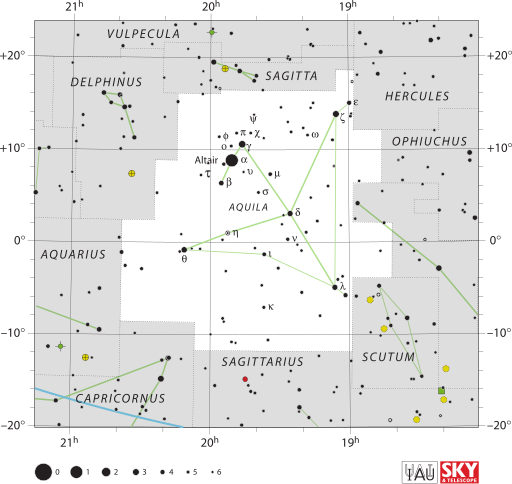 3. Aquila (Ἀετός: Aql). A northern constellation depicting an eagle. An ancient constellation which was well known to the Babylonians. It occurs in the Three Stars Each as A-mushen 'Eagle', being one of the 'Stars of Akkad' and in the MUL.APIN tablets as one of the 'Stars of Anu'. It contains the bright star Altair (magnitude 0.76).
3. Aquila (Ἀετός: Aql). A northern constellation depicting an eagle. An ancient constellation which was well known to the Babylonians. It occurs in the Three Stars Each as A-mushen 'Eagle', being one of the 'Stars of Akkad' and in the MUL.APIN tablets as one of the 'Stars of Anu'. It contains the bright star Altair (magnitude 0.76).The Eagle is mentioned a few times by Aratos, for example, as a storm bird (313–5) and as a messenger of Zeus (522).
Hipparchos mentions 5 stars in Aquila (2.5.13, 2.6.13) and Ptolemy increases this to 15 (7.5.16, H2.72–4).
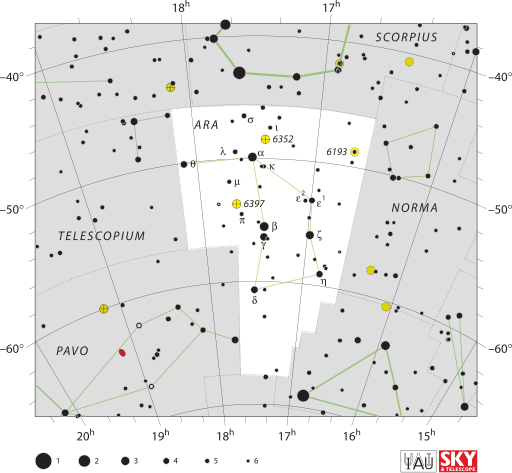 4. Ara (Θυμιατήριον: Ara). A southern constellation depicting an altar. It seems to have been an invention of the Greeks and was known to them as θυμιατήριον or θυτήριον 'altar, censer', it may have got its name from its proximity to the Milky Way which reminded them of the fumes rising from a burnt sacrifice.
4. Ara (Θυμιατήριον: Ara). A southern constellation depicting an altar. It seems to have been an invention of the Greeks and was known to them as θυμιατήριον or θυτήριον 'altar, censer', it may have got its name from its proximity to the Milky Way which reminded them of the fumes rising from a burnt sacrifice.Aratos (402–419) associates this constellation with bad weather for sailors.
Hipparchos mentions 8 stars in Ara (3.1.6, 3.2.6) while Ptolemy, unusually, lists fewer with only 7 (8.1.46, H2.164).
 |
| Argo Navis by Hevelius. |
It contains the second brightest star in the sky Canopus (α Carinae), known to the Greeks as Κάνωβος, whose declination was such that it was not visible from mainland Greece but was visible from southern Ionia and Egypt.
Aratos mentions the Argo several times but gives one main description (342–52) of it travelling backwards in the sky and alludes briefly to the myth.
Hipparchos mentions 9 stars in Argo Navis (3.1.14, 3.2.14) and Ptolemy records (8.1.40, H2.146–52) 45 stars.
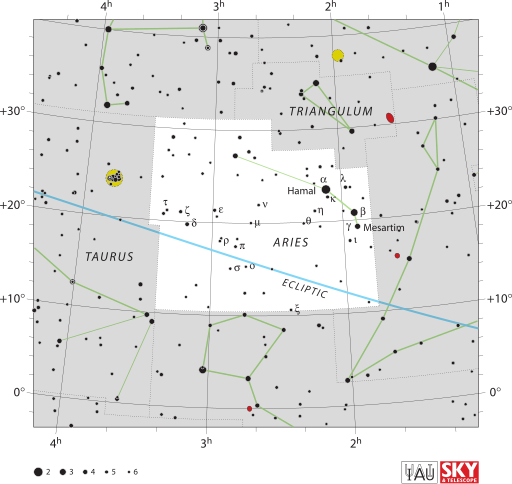 6. Aries (Κριός: Ari ♈). A zodiacal constellation depicting the Ram. It occupies the first sign of the zodiac which originally ran from 0° to 30° of ecliptic longitude and was known to the Greeks at least since the time of Eudoxos. A constellation of the same name was first known to the Mesopotamians as Lu.HUNG.GA 'hired labourer' in the MUL.APIN tablets. The brightest star, Hamal (α Ari, magnitude 2.00), lies in the middle of the constellation and its heliacal rising marked the spring equinox around 1600 BCE on 4th April in the proleptic Julian Calendar. It is thought that later Mesopotamian tradition redesignated it as the Ram when the zodiac was devised during the C5th BCE (Rogers 1998–I, 27) although the process is far from clear.
6. Aries (Κριός: Ari ♈). A zodiacal constellation depicting the Ram. It occupies the first sign of the zodiac which originally ran from 0° to 30° of ecliptic longitude and was known to the Greeks at least since the time of Eudoxos. A constellation of the same name was first known to the Mesopotamians as Lu.HUNG.GA 'hired labourer' in the MUL.APIN tablets. The brightest star, Hamal (α Ari, magnitude 2.00), lies in the middle of the constellation and its heliacal rising marked the spring equinox around 1600 BCE on 4th April in the proleptic Julian Calendar. It is thought that later Mesopotamian tradition redesignated it as the Ram when the zodiac was devised during the C5th BCE (Rogers 1998–I, 27) although the process is far from clear.Aratos gives no associated myth for the constellation (225–30) but describes it as faint and fleet.
Hipparchos mentions 9 stars in Aries (3.3.10, 3.4.10) and Ptolemy has 18 stars (7.5.22, H2.84) including 5 just outside.
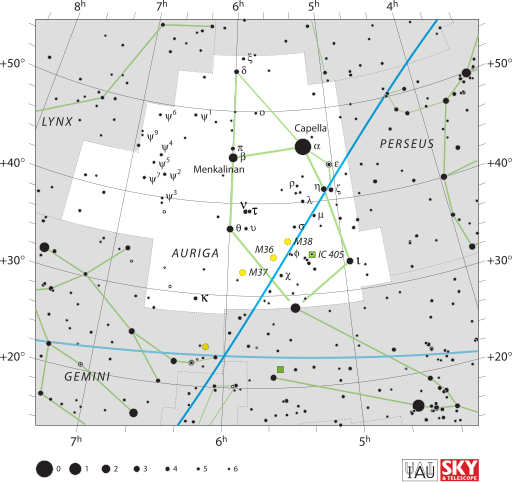 7. Auriga (Ἡνίοχος: Aur). A northern constellation depicting a charioteer. The origins of this constellation are obscure. The Mesopotamian tradition identifies the area with MUL.GAM 'goatherd's crook'. However, the Greek is clearly ἡνίοχος. 'one who holds the reins', so it appears to be a Greek invention. A complicating factor is that there is an alternative Greek tradition known to Aratos (157–8), Hipparchos (1.5.15) and Ptolemy (7.5.12, H66), which says that the brightest star in the constellation, Capella (α Aurigae), was known as 'the Goat', and the two stars ζ and η Aurigae as 'the Kids'.
7. Auriga (Ἡνίοχος: Aur). A northern constellation depicting a charioteer. The origins of this constellation are obscure. The Mesopotamian tradition identifies the area with MUL.GAM 'goatherd's crook'. However, the Greek is clearly ἡνίοχος. 'one who holds the reins', so it appears to be a Greek invention. A complicating factor is that there is an alternative Greek tradition known to Aratos (157–8), Hipparchos (1.5.15) and Ptolemy (7.5.12, H66), which says that the brightest star in the constellation, Capella (α Aurigae), was known as 'the Goat', and the two stars ζ and η Aurigae as 'the Kids'.Aratos mentions the constellation several times and introduces it (156–66) as a figure carrying a goat and kids but gives no further explanation.
Hipparchos mentions 9 stars in Auriga (2.5.16, 2.6.16) and Ptolemy lists 14 stars (7.5.12, H2.66).
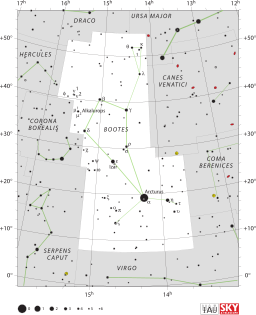 8. Boötes (βοώτης: Boö). A northern constellation variously translated as the Herdsman, Oxherd or Ploughman (oxen were used for ploughing in ancient Greece and elsewhere). The bright star Arcturus dominates the constellation and both it and the whole constellation was traditionally also known as the 'Bear–Watcher' or 'Bear–Keeper (Ἀρκτοφύλαξ) since the tail of Ursa Major curves down towards it.
8. Boötes (βοώτης: Boö). A northern constellation variously translated as the Herdsman, Oxherd or Ploughman (oxen were used for ploughing in ancient Greece and elsewhere). The bright star Arcturus dominates the constellation and both it and the whole constellation was traditionally also known as the 'Bear–Watcher' or 'Bear–Keeper (Ἀρκτοφύλαξ) since the tail of Ursa Major curves down towards it.The connection with Mesopotamia is weak, but in the Three Stars Each and MUL.APIN the constellation, or perhaps just Arcturus, is known as SHU.PA, one of the Stars of Akkad, and is identified with a yoke (Rogers 1998–I: 16)
Aratos mentions it several times and gives an explanation of the name (91–5).
Hipparchos mentions 10 stars in Boötes (2.5.1, 2.6.1) and Ptolemy lists 23 (7.5.5, H2.48–50) including one outside the constellation.
Caelum (Cae, the Chisel). A faint southern constellation introduced by Nicolas–Louis de Lacaille in 1763.
Camelopardalis (Cam, the Giraffe). A large but faint northern constellation introduced by Petrus Plancius in 1613.
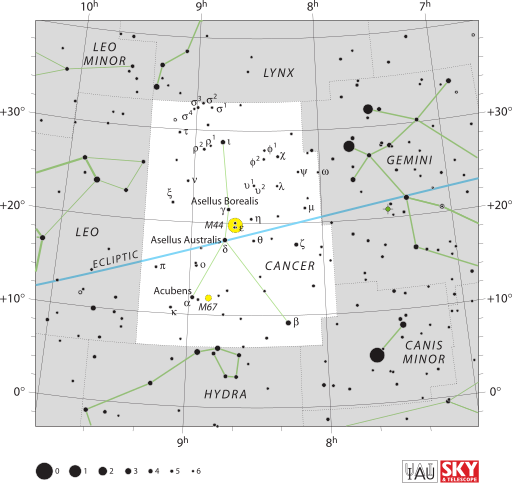 9. Cancer (Καρκίνος: Cnc ♋). A zodiacal constellation depicting a crab . It occupies the fourth sign of the zodiac which originally ran from 90° to 120° of ecliptic longitude. A constellation of the same name was originally known to the Mesopotamians as al.lul 'crab' and dates back to the Three Stars Each catalogue, although being a fairly faint constellation its form has varied over time. It has no really bright stars and its most notable feature is the Praesepe star cluster (M44, aggregate magnitude 3.10), the heliacal rising of which on 11th July in the proleptic Julian Calendar would have marked the summer solstice around 2000 BCE.
9. Cancer (Καρκίνος: Cnc ♋). A zodiacal constellation depicting a crab . It occupies the fourth sign of the zodiac which originally ran from 90° to 120° of ecliptic longitude. A constellation of the same name was originally known to the Mesopotamians as al.lul 'crab' and dates back to the Three Stars Each catalogue, although being a fairly faint constellation its form has varied over time. It has no really bright stars and its most notable feature is the Praesepe star cluster (M44, aggregate magnitude 3.10), the heliacal rising of which on 11th July in the proleptic Julian Calendar would have marked the summer solstice around 2000 BCE.Aratos mentions the constellation several times (e.g. line 147) but has little to say about it except to give positional information and to state (500) its connection with the Tropic of Cancer.
Hipparchos discusses (3.3.1, 3.4.1) 7 stars in Cancer and Ptolemy lists 13 (7.5.25, H2.96–8) including 4 outside it.
Canes Venaticis (CVn, the Hunting Dogs). A northern constellation introduced by Johannes Hevelius in 1690.
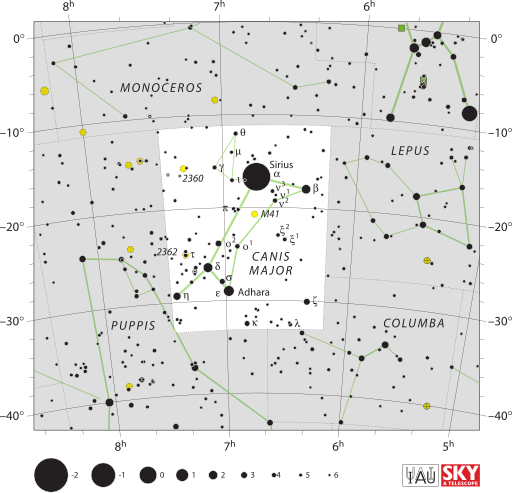 10. Canis Major (Κύων Μέγας: CMa). A southern constellation usually referred to as simply 'The Dog' without the qualification of size, and identified from earliest times as the dog of the hunter Orion (Homer: Iliad 22.29) whose constellation is close by. It seems to have been a Greek invention.
10. Canis Major (Κύων Μέγας: CMa). A southern constellation usually referred to as simply 'The Dog' without the qualification of size, and identified from earliest times as the dog of the hunter Orion (Homer: Iliad 22.29) whose constellation is close by. It seems to have been a Greek invention.The constellation is dominated by the brightest star in the sky, Sirius (α CMa), the so called Dog Star, whose Greek name Σείριος may mean 'scorching', and is found as early as Hesiod (Works and Days 417, 587, 609). This was due to a general belief that the star was responsible for the excessive heat of summer (particularly perhaps the nights) following its heliacal rising in July.
There is no mention of the whole constellation in Babylonian documents but Sirius is found in Three Stars Each and MUL.APIN as KAK.SI.DI or KAK.SI.SA meaning 'arrow'. In ancient Egypt, likewise, Sirius was the only part of the constellation that was given prominence and it was known as Sopdet (Greek Σῶθις). Its heliacal rising in mid July presaged the onset of the annual flooding of the Nile.
Aratos mentions the constellation several times, and in one passage (326–337) gives a brief description of it and alludes to the connection with Orion and the heat of Summer. Hipparchos knows (3.1.12, 3.2.12) a total of 7 stars in Canis Major, while Ptolemy lists 29 (8.1.38, H2.142–146) including 11 just outside it.
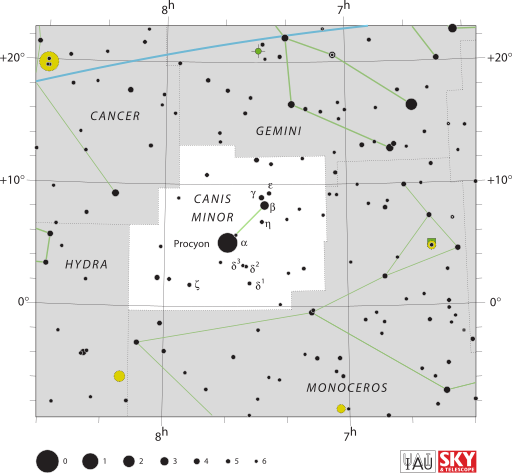 11. Canis Minor (Προκύων: CMi). For the Greeks there was little more to this constellation than its brightest star Procyon (α CMi) whose name means effectively 'fore–dog', that is, the star that leads the constellation of the Dog (Canis Major), since it rises before Sirius.
11. Canis Minor (Προκύων: CMi). For the Greeks there was little more to this constellation than its brightest star Procyon (α CMi) whose name means effectively 'fore–dog', that is, the star that leads the constellation of the Dog (Canis Major), since it rises before Sirius.For the Babylonians, Procyon and the fainter Gomeisa (β CMi) were known as MASH.TAB.BA 'The Twins' in Three Stars Each, while in MUL.APIN these stars are identified with the gods Lulal and Latarak.
Aratos has little to say about it except to give brief positional information (450, 595, 690). Hipparchos recognises 3 stars in Canis Minor (3.1.13, 3.2.13) while Ptolemy lists only 2 (8.1.39, H2.146).
 12. Capricornus (Αἰγόκερως: Cap ♑). A zodiacal constellation depicting a horned goat. It occupies the tenth sign zodiac which originally ran from 270° to 300° of ecliptic longitude. The corresponding zodiacal sign is known by the slightly different name of Capricorn.
12. Capricornus (Αἰγόκερως: Cap ♑). A zodiacal constellation depicting a horned goat. It occupies the tenth sign zodiac which originally ran from 270° to 300° of ecliptic longitude. The corresponding zodiacal sign is known by the slightly different name of Capricorn.The constellation was originally known to the Babylonians as SUHUR.MASH 'Fish-Goat' and occurs in the MUL.APIN tablets.
Aratos gives it only two brief positional acknowledgments (284, 684). but also makes the connection (501) between it and the Tropic of Capricorn. Hipparchos mentions (3.3.7, 3.4.7) a total of 12 stars in Capricornus, while Ptolemy lists 28 (8.1.31, H2.116–8).
Carina (Car, the Keel). Split off from the ancient Argo by Nicolas–Louis de Lacaille in 1763.
 13. Cassiopeia (Κασσιέπεια: Cas). A northern constellation named after Cassiopeia, Queen of Ethiopia who boasted that she and her daughter, Andromeda, were more beautiful than the Nereids. A very recognisable constellation from its 'M' or 'W' asterism which is actually supposed to be the outline of the queen's throne (or chair of confinement, depending upon the version of the myth).
13. Cassiopeia (Κασσιέπεια: Cas). A northern constellation named after Cassiopeia, Queen of Ethiopia who boasted that she and her daughter, Andromeda, were more beautiful than the Nereids. A very recognisable constellation from its 'M' or 'W' asterism which is actually supposed to be the outline of the queen's throne (or chair of confinement, depending upon the version of the myth).This constellation is a Greek invention. The Babylonians in Three Stars Each and MUL.APIN knew this group of stars as Lu.LIM, a deer.
Aratos describes the constellation in two places and in some detail (189, 654), and alludes to the myth. Hipparchos knows 8 stars in the constellation (2.5.9, 2.6.9) while Ptolemy lists 13 (7.5.10, H2.60–2).
 14. Centaurus (Κένταυρος: Cen). A southern constellation depicting a centaur, the Greek mythical creature comprising the upper body of a human and the lower body and legs of a horse. It is one of two constellations based on a centaur, the other being Sagittarius.
14. Centaurus (Κένταυρος: Cen). A southern constellation depicting a centaur, the Greek mythical creature comprising the upper body of a human and the lower body and legs of a horse. It is one of two constellations based on a centaur, the other being Sagittarius.Not surprisingly the constellation was unknown to the Babylonians who divided this region of the sky up quite differently.
Aratos mentions the Centaur several times, giving good positional information (431–42). but does not allude to any associated myth. Hipparchos knows 11 stars in Centaurus (3.1.4, 3.2.4) and Ptolemy lists 37 (8.1.44, H2.158–62).
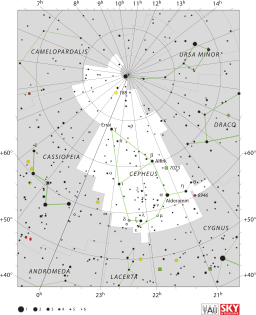 15. Cepheus (Κηφεύς: Cep). A northern constellation named after Cepheus, king of Ethiopia, husband of Queen Cassiopeia, and father of princess Andromeda.
15. Cepheus (Κηφεύς: Cep). A northern constellation named after Cepheus, king of Ethiopia, husband of Queen Cassiopeia, and father of princess Andromeda.The Babylonians divided up this part of the sky completely differently, assigning part of the constellation to UD.KA.DUH.A, a panther-griffin figure. The constellation is, therefore a Greek invention.
Aratos mentions Cepheus a few times and gives his principal description (179–187) near the beginning of the poem. Hipparchos records 12 stars in the constellation (2.5.8, 2.6.8) and Ptolemy lists 13 (7.5.4, H2.46–48).
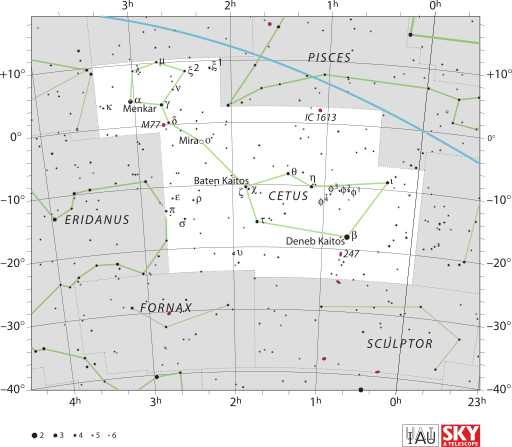 16. Cetus (κῆτος: Cet). A large equatorial constellation which depicts the sea monster that Poseidon sent to attack Andromeda and which was killed by Perseus. The constellation is usually referred to as the Whale in English, even though the original Greek is an imaginary creature.
16. Cetus (κῆτος: Cet). A large equatorial constellation which depicts the sea monster that Poseidon sent to attack Andromeda and which was killed by Perseus. The constellation is usually referred to as the Whale in English, even though the original Greek is an imaginary creature.The Babylonians took no interest in his part of the sky and the constellation, like others of the Andromeda myth, is a Greek invention.
Aratos makes use of Cetus numerous times as a positional indicator and alludes to the myth (353–364). Hipparchos knows of 14 stars in Cetus (3.1.8, 3.2.8) while Ptolemy lists 22 (8.1.34, H2.130–132).
Chamaeleon (Cha, the Chamaeleon). A southern constellation devised by Petrus Plancius (Pieter Platevoet) in 1598 from observations by Pieter Dirkszoon Keyser and Frederick de Houtman. It was included in Uranometria published in 1603 by Johann Bayer.
Circinus (Cir, the Draftsman's Compass). A southern constellation devised by Nicolas–Louis de Lacaille in 1763.
Columba (Col, the Dove). A small southern constellation separated off from Canis Major in 1592 by Petrus Plancius.
Coma Berenices (Com, the Hair of Berenice). A northern constellation split off from Leo by Johann Bayer an published in his Uranometria in 1603. The constellation was suggested by Konon of Samos (c. 240 BCE) but was disregarded by Hipparchos and Ptolemy.
 17. Corona Australis (Στέφανος Νότιος: CrA). A southern constellation known as the Southern Crown, though in origin it was a wreath, and the counterpart to Corona Borealis.
17. Corona Australis (Στέφανος Νότιος: CrA). A southern constellation known as the Southern Crown, though in origin it was a wreath, and the counterpart to Corona Borealis.The Babylonians did not see this as a separate constellation and may have included it as part of Sagittarius.
It is not found in Eudoxos, Aratos or Hipparchos. However, it may have been devised by Hipparchos (as we know Equuleus to have been), but not mentioned in his extant work or fragments. It appears for the first time in Ptolemy, who lists a total of 13 stars (8.1.47, H2.164–166).
 18. Corona Borealis (Στέφανος Βόρειος). A compact and fairly bright northern constellation known as the Northern Crown, though in origin it was a wreath, like its newer southern counterpart. It was traditionally regarded as belonging to the Cretan princess Ariadne.
18. Corona Borealis (Στέφανος Βόρειος). A compact and fairly bright northern constellation known as the Northern Crown, though in origin it was a wreath, like its newer southern counterpart. It was traditionally regarded as belonging to the Cretan princess Ariadne.Despite its prominence it does not seem to have been much noticed in the Babylonian star catalogues, and may therefore be regarded as a Greek invention.
Aratos refers to it several times and the myth once (71–73. Hipparchos knows (2.5.2, 2.6.2) 6 stars in the constellation (the ones that essentially define the shape), while Ptolemy records 8 (7.5.6, H2.52).
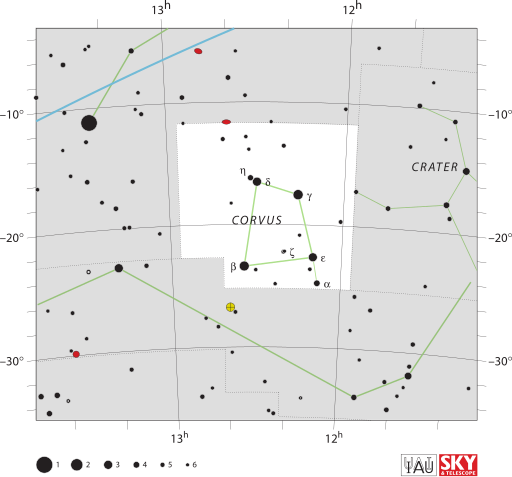 19. Corvus (Κόραξ: Crv). A southern constellation, readily identified by a bright quadrilateral of stars, either rendered as the Crow or the Raven. It was loosely associated with Apollo but there is no specific myth.
19. Corvus (Κόραξ: Crv). A southern constellation, readily identified by a bright quadrilateral of stars, either rendered as the Crow or the Raven. It was loosely associated with Apollo but there is no specific myth.The Babylonians in both Three Stars Each and MUL.APIN also recognised this formation of stars as a raven, UGA-Mushen, so there seems to be a prima facie case for a borrowing into Greek skylore.
Aratos makes only two references to the constellation (449, 520) which are both positional statements. Hipparchos (3.1.3, 3.2.3) mentions 6 stars and Ptolemy (8.1.43, H2.156–8) a total of 7.
 20. Crater (Κρατήρ: Crt). A small and rather faint southern constellation properly rendered as the Mixing Bowl but often known as the Cup. Like Crater, this constellation is associated with Apollo.
20. Crater (Κρατήρ: Crt). A small and rather faint southern constellation properly rendered as the Mixing Bowl but often known as the Cup. Like Crater, this constellation is associated with Apollo.The constellation was also associated by the Babylonians with the Raven.
Aratos makes three passing references to it (448, 520, 603) but gives briefly positional information only. Hipparchos (3.1.2, 3.2.2) mentions just 3 stars in Krater, and Ptolemy (8.1.42, H2.156) 7 stars.
Crux (Cru, the Southern Cross). Split off from Centaurus and published by Johann Bayer in his Uranometria in 1603.
 21. Cygnus (Ὄρνις: Cyg). A prominent northern constellation which the Greeks knew mainly as the Bird. Sometimes it was associated with a hen, but the designation as the Swan (Κύκνος) seems to have started in the Catasterisms of Pseudo-Eratosthenes. A connection with the myth of Leda and the Swan was readily made, and the Romans adopted it as the Swan.
21. Cygnus (Ὄρνις: Cyg). A prominent northern constellation which the Greeks knew mainly as the Bird. Sometimes it was associated with a hen, but the designation as the Swan (Κύκνος) seems to have started in the Catasterisms of Pseudo-Eratosthenes. A connection with the myth of Leda and the Swan was readily made, and the Romans adopted it as the Swan.The Babylonians in both Three Stars Each and MUL.APIN designated this area of sky as UD.KA.DUH.A, a panther-griffin. It is unclear whether there is any influence over the Greek perception.
Aratos has a few scattered positional references and one more detailed passage (273–80) alluding to a connection with Zeus. Hipparchos mentions 13 stars in Cygnus (2.5.7, 2.6.7), while Ptolemy lists 19, including 2 just outside it (7.5.9, H2.58–60).
 22. Delphinus (Δελφίς: Del). A small and rather faint northern constellation. It is associated with the legend (Herodotus 1.23–24) of the early Greek poet Arion who was rescued by a dolphin after throwing himself overboard when he was threatened by the crew of a ship.
22. Delphinus (Δελφίς: Del). A small and rather faint northern constellation. It is associated with the legend (Herodotus 1.23–24) of the early Greek poet Arion who was rescued by a dolphin after throwing himself overboard when he was threatened by the crew of a ship.The Babylonians assigned no specific constellation to this area of sky and it the Dolphin seems to be a Greek invention.
Aratos only mentions Delphinus twice (316, 598) to give positional information. Hipparchos (2.5.14, 2.6.14) knows of 6 stars in the constellation, while Ptolemy lists (7.5.17, H2.74–76) 10.
Dorado (Dor, the Dolphinfish / Swordfish). A southern constellation devised by Petrus Plancius (Pieter Platevoet) in 1598 from observations by Pieter Dirkszoon Keyser and Frederick de Houtman. It was included in Uranometria published in 1603 by Johann Bayer.
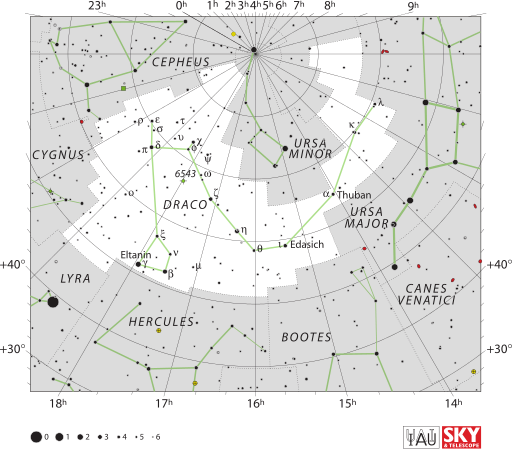 23. Draco (Δράκων: Dra). A northern circumpolar constellation, the Dragon, which separates the two bears (Ursa Major and Ursa Minor). Sometimes Greek writers refer to it as the Snake (Ὄφις) though this is more properly reserved for the constellation of Serpens.
23. Draco (Δράκων: Dra). A northern circumpolar constellation, the Dragon, which separates the two bears (Ursa Major and Ursa Minor). Sometimes Greek writers refer to it as the Snake (Ὄφις) though this is more properly reserved for the constellation of Serpens.The Babylonians had no specific star grouping for this area of sky, and the constellation is, therefore, a Greek invention.
Aratos gives a long (45–62) positional description of the constellation, a fact which emphasises its usefulness for orientation, although he mentions no associated myth. Since Draco does not rise or set, Hipparchos does not have a catalogue entry for it, but mentions 10 stars in all (all in book 1), while Ptolemy lists 31 (7.5.3, H2.42–6).
 24. Equuleus (Ἵππου Προτομή: Equ). A small and faint northern constellation.. The Greek translates literally as 'Bust of a Horse', but it is now generally known as the 'Little Horse'. It lies next to Pegasus which may be regarded as the 'Great Horse'.
24. Equuleus (Ἵππου Προτομή: Equ). A small and faint northern constellation.. The Greek translates literally as 'Bust of a Horse', but it is now generally known as the 'Little Horse'. It lies next to Pegasus which may be regarded as the 'Great Horse'.The Babylonians did not envisage anything specific for this part of the sky, and the constellation seems to have been invented by Hipparchos, according to Geminos (Introduction to the Phenomena 3.8), although it does not occur in his Commentary on the Phenomena of Aratos and Eudoxos.
Equuleus was included by Ptolemy in his star catalogue and he lists 4 stars in the constellation (7.5.18, H2.76).
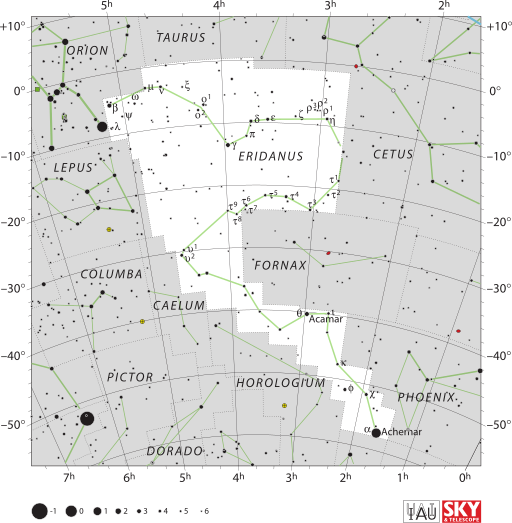 25. Eridanus (Ὠρίωνος Ποταμός: Eri). A large and straggly southern constellation, usually known simply as the 'River' or the 'River of Orion'. It is sometimes identified with the River Po in Italy or with a small (now underground) stream in Athens.
25. Eridanus (Ὠρίωνος Ποταμός: Eri). A large and straggly southern constellation, usually known simply as the 'River' or the 'River of Orion'. It is sometimes identified with the River Po in Italy or with a small (now underground) stream in Athens.The Babylonians had no specific constellation for this area of sky and thus it appears to be a Greek invention.
Aratos mentions the constellation a few times and once (360) with the specific name Ἠριδανός. Hipparchos knows 3 stars (3.1.10, 3.2.10) in the constellation, while Ptolemy lists 34 (8.1.36, H2.136–40), including one (α Eri) not visible from Alexandria.
Fornax (For, the Furnace). A southern constellation devised by Nicolas–Louis de Lacaille in 1763.
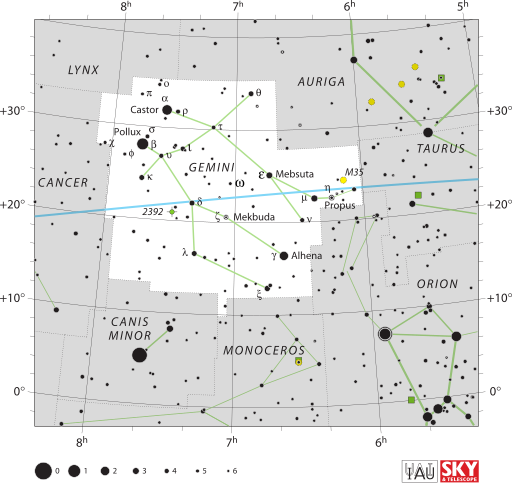 26. Gemini (Δίδυμοι: Gem ♊). A zodiacal constellation depicting twins whose sign originally ran from 60° to 90° of ecliptic longitude.
26. Gemini (Δίδυμοι: Gem ♊). A zodiacal constellation depicting twins whose sign originally ran from 60° to 90° of ecliptic longitude.A constellation of the same name was originally known to the Mesopotamians as MASH.TAB.BA.GAL.GAL.LA 'the great twins', who were gods who guarded doorways (first recorded in the Three Stars Each tablets.
Aratos mentions the constellation several times but only to give positional information. Hipparchos mentions 11 stars in Gemini (3.3.12, 3.4.12), while Ptolemy lists 25 (7.5.24, H2.92), including 7 just outside it.
Grus (Gru, the Crane). A southern constellation devised by Petrus Plancius (Pieter Platevoet) in 1598 from observations by Pieter Dirkszoon Keyser and Frederick de Houtman. It was included in Uranometria published in 1603 by Johann Bayer.
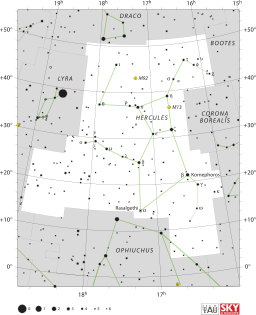 27. Hercules (Ἐνγόνασιν: Her). A large northern constellation and not particularly bright. The Greeks saw this constellation simply as a man on his knees and the Greek name means simply 'The Kneeler'. The association with Hercules/Herakles is first recorded by the C1st BCE historian Dionysios of Halikarnassos.
27. Hercules (Ἐνγόνασιν: Her). A large northern constellation and not particularly bright. The Greeks saw this constellation simply as a man on his knees and the Greek name means simply 'The Kneeler'. The association with Hercules/Herakles is first recorded by the C1st BCE historian Dionysios of Halikarnassos.The Babylonians ascribed at least part of this area of sky to UR.KU, a dog, in both Three Stars Each and MUL.APIN. Thus there seems to be no strong connection with the Greek constellation.
Aratos frequently mentions Hercules, and gives positional information (64–70) but no mythology. Hipparchos mentions 14 stars in Hercules (2.5.3, 2.6.3), while Ptolemy lists 28 (7.5.7, H2.52–6).
Horologium (Hor, the Pendulum Clock). A southern constellation devised by Nicolas–Louis de Lacaille in 1763.
The Babylonians also envisaged a snake, MUSH, in this part of the sky who represented Nigizzida and guarded the entrance to the underworld. Thus, there may be a connection with the Greek constellation.
Aratos mentions Hydra several times, giving it the feminine form Ὕδρῃ, and gives the main description in lines 443–449, but does not include any associated myth. Hipparchos prefers the masculine form and knows 15 stars in the constellation (3.1.1, 3.2.1), while Ptolemy lists 27 (8.1.41, H2.152–56) including 2 classified as being outside it.
Hydrus (Hyi, the Lesser Water–Snake). A southern constellation devised by Petrus Plancius (Pieter Platevoet) in 1598 from observations by Pieter Dirkszoon Keyser and Frederick de Houtman. It was included in Uranometria published in 1603 by Johann Bayer.
Indus (Ind, The Indian). A southern constellation devised by Petrus Plancius (Pieter Platevoet) in 1598 from observations by Pieter Dirkszoon Keyser and Frederick de Houtman. It was included in Uranometria published in 1603 by Johann Bayer.
Lacerta (Lac, the Lizard). A Northern constellation devised by Johannes Hevelius in 1690.
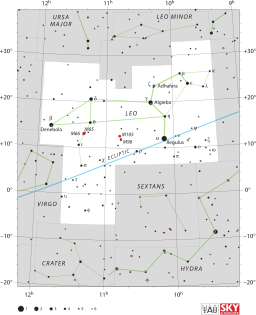 29. Leo. The Lion ♌. The fifth sign of the zodiac which originally ran from 120° to 150° of ecliptic longitude and was known to the Greeks at least since the time of Eudoxos as λέων 'lion'. The denominating constellation of the same name was one of the four Mesopotamian founder constellations (UR.GU.LA 'lion') which originated c. 3900 BCE, when the heliacal rising of its brightest star, Regulus (α Leo, magnitude 1.35), around 23rd July marked the summer solstice.
29. Leo. The Lion ♌. The fifth sign of the zodiac which originally ran from 120° to 150° of ecliptic longitude and was known to the Greeks at least since the time of Eudoxos as λέων 'lion'. The denominating constellation of the same name was one of the four Mesopotamian founder constellations (UR.GU.LA 'lion') which originated c. 3900 BCE, when the heliacal rising of its brightest star, Regulus (α Leo, magnitude 1.35), around 23rd July marked the summer solstice.
Leo Minor (LMi, the Lesser Lion). A northern constellation devised by Johannes Hevelius in 1690.
30. Lepus.
31. Libra.
32. Lupus.
Lynx (Lyn, the Lynx). A northern constellation devised by Johannes Hevelius in 1690.
33. Lyra.
Mensa (Men, the Table). A southern constellation devised by Nicolas–Louis de Lacaille in 1763.
Microscopium (Mic, the Microscope). A southern constellation devised by Nicolas–Louis de Lacaille in 1763.
Monoceros (Mon, the Unicorn). A southern constellation devised by Petrus Plancius in 1613.
Musca (Mus, the Fly). A southern constellation devised by Petrus Plancius (Pieter Platevoet) in 1598 from observations by Pieter Dirkszoon Keyser and Frederick de Houtman. It was included in Uranometria published in 1603 by Johann Bayer.
Norma (Nor, the Set Square). A southern constellation devised by Nicolas–Louis de Lacaille in 1763.
Octans (Oct, the Octant). A southern constellation devised by Nicolas–Louis de Lacaille in 1763.
34. Ophiuchus.
35. Orion.
Pavo (Pav, the Peacock). A southern constellation devised by Petrus Plancius (Pieter Platevoet) in 1598 from observations by Pieter Dirkszoon Keyser and Frederick de Houtman. It was included in Uranometria published in 1603 by Johann Bayer.
36. Pegasus.
37. Perseus.
Phoenix (Phe, the Phoenix). A southern constellation devised by Petrus Plancius (Pieter Platevoet) in 1598 from observations by Pieter Dirkszoon Keyser and Frederick de Houtman. It was included in Uranometria published in 1603 by Johann Bayer.
Pictor (Pic, the Painter / Easel). A southern constellation devised by Nicolas–Louis de Lacaille in 1763.
38. Pisces.
39. Piscis Austrinus.
Puppis (Pup, the Stern). A southern constellation separated off from the Argo by Nicolas–Louis de Lacaille in 1763.
Pyxis (Pyx, the Mariner's Compass). A southern constellation devised by Nicolas–Louis de Lacaille in 1763.
Reticulum (Ret, the Eyepiece Graticule). A southern constellation devised by Nicolas–Louis de Lacaille in 1763.
40. Sagitta.
41. Sagittarius.
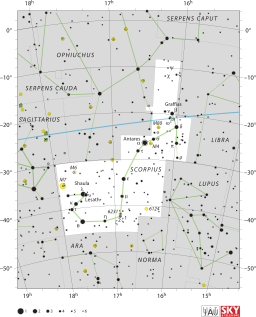 42. Scorpius. The Scorpion ♏. The eighth sign of the zodiac which originally ran from 210° to 240° of ecliptic longitude and was known to the Greeks since at least the time of Eudoxos as σκορπίος 'scorpion'. The denominating constellation, which is actually called Scorpius, was one of the four Mesopotamian founder constellations (GIR.TAB 'scorpion') which originated c. 4100 BCE, when the heliacal rising of its brightest star, Antares (α Sco, magnitude 1.05), around 23rd October marked the autumnal equinox.
42. Scorpius. The Scorpion ♏. The eighth sign of the zodiac which originally ran from 210° to 240° of ecliptic longitude and was known to the Greeks since at least the time of Eudoxos as σκορπίος 'scorpion'. The denominating constellation, which is actually called Scorpius, was one of the four Mesopotamian founder constellations (GIR.TAB 'scorpion') which originated c. 4100 BCE, when the heliacal rising of its brightest star, Antares (α Sco, magnitude 1.05), around 23rd October marked the autumnal equinox.
Sculptor (Scl, the Sculptor). A southern constellation devised by Nicolas–Louis de Lacaille in 1763.
Scutum (Sct, the Shield). A northern constellation devised by Johannes Hevelius in 1690.
43. Serpens.
Sextans (Sex, the Sextant). An equatorial constellation devised by Johannes Hevelius in 1690.
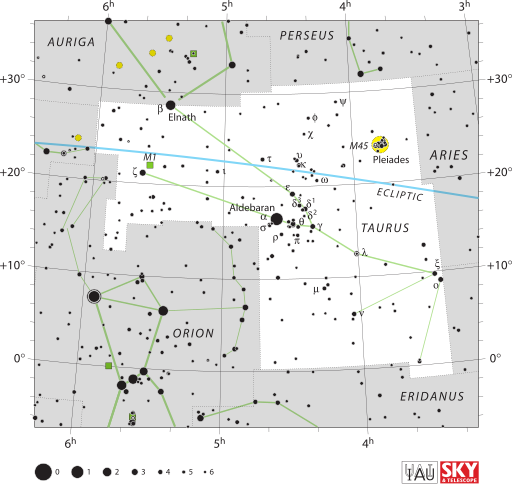 44. Taurus. The Bull ♉. The second sign of the zodiac which originally ran from 30° to 60° of ecliptic longitude and was known to the Greeks since at least the time of Eudoxos as ταῦρος 'bull'. The denominating constellation of the same name is one of the four Mesopotamian founder constellations (GU4.AN.NA 'Bull of Heaven') which originated c. 3700 BCE, when the heliacal rising of its brightest asterism, The Pleiades (aggregated magnitude 1.20), around 20th April marked the spring equinox.
44. Taurus. The Bull ♉. The second sign of the zodiac which originally ran from 30° to 60° of ecliptic longitude and was known to the Greeks since at least the time of Eudoxos as ταῦρος 'bull'. The denominating constellation of the same name is one of the four Mesopotamian founder constellations (GU4.AN.NA 'Bull of Heaven') which originated c. 3700 BCE, when the heliacal rising of its brightest asterism, The Pleiades (aggregated magnitude 1.20), around 20th April marked the spring equinox.
Telescopium (Tel, the Telescope). A southern constellation devised by Nicolas–Louis de Lacaille in 1763.
45. Triangulum.
Triangulum Australe (TrA, the Southern Triangle). A southern constellation devised by Petrus Plancius (Pieter Platevoet) in 1598 from observations by Pieter Dirkszoon Keyser and Frederick de Houtman. It was included in Uranometria published in 1603 by Johann Bayer.
Tucana (Tuc, the Toucan). A southern constellation devised by Petrus Plancius (Pieter Platevoet) in 1598 from observations by Pieter Dirkszoon Keyser and Frederick de Houtman. It was included in Uranometria published in 1603 by Johann Bayer.
46. Ursa Major.
47. Ursa Minor.
48. Virgo.
Vela (Vel, the Sails). A southern constellation separated off from the Argo by Nicolas–Louis de Lacaille in 1763.
Volans (Vol, the Flying Fish). A southern constellation devised by Petrus Plancius (Pieter Platevoet) in 1598 from observations by Pieter Dirkszoon Keyser and Frederick de Houtman. It was included in Uranometria published in 1603 by Johann Bayer.
Vulpecula (Vul, the Little Fox). A northern constellation devised by Johannes Hevelius in 1690.
REFERENCES
Allen, Richard Hinckley (1899). Star Names and their Meanings. (Dover edition 1963 Star Names: Their Lore and Meaning. New York).
Rogers, John H. (1998-I). 'Origins of the ancient constellations: I. The Mesopotamian traditions'. Journal of the British Astronomical Association, 108, 9–28.
Rogers, John H. (1998-II). 'Origins of the ancient constellations: II. The Mediterranean traditions'. Journal of the British Astronomical Association, 108, 79–89.
Last updated 14/07/2020
Hydrus (Hyi, the Lesser Water–Snake). A southern constellation devised by Petrus Plancius (Pieter Platevoet) in 1598 from observations by Pieter Dirkszoon Keyser and Frederick de Houtman. It was included in Uranometria published in 1603 by Johann Bayer.
Indus (Ind, The Indian). A southern constellation devised by Petrus Plancius (Pieter Platevoet) in 1598 from observations by Pieter Dirkszoon Keyser and Frederick de Houtman. It was included in Uranometria published in 1603 by Johann Bayer.
Lacerta (Lac, the Lizard). A Northern constellation devised by Johannes Hevelius in 1690.
 29. Leo. The Lion ♌. The fifth sign of the zodiac which originally ran from 120° to 150° of ecliptic longitude and was known to the Greeks at least since the time of Eudoxos as λέων 'lion'. The denominating constellation of the same name was one of the four Mesopotamian founder constellations (UR.GU.LA 'lion') which originated c. 3900 BCE, when the heliacal rising of its brightest star, Regulus (α Leo, magnitude 1.35), around 23rd July marked the summer solstice.
29. Leo. The Lion ♌. The fifth sign of the zodiac which originally ran from 120° to 150° of ecliptic longitude and was known to the Greeks at least since the time of Eudoxos as λέων 'lion'. The denominating constellation of the same name was one of the four Mesopotamian founder constellations (UR.GU.LA 'lion') which originated c. 3900 BCE, when the heliacal rising of its brightest star, Regulus (α Leo, magnitude 1.35), around 23rd July marked the summer solstice.Leo Minor (LMi, the Lesser Lion). A northern constellation devised by Johannes Hevelius in 1690.
30. Lepus.
31. Libra.
32. Lupus.
Lynx (Lyn, the Lynx). A northern constellation devised by Johannes Hevelius in 1690.
33. Lyra.
Mensa (Men, the Table). A southern constellation devised by Nicolas–Louis de Lacaille in 1763.
Microscopium (Mic, the Microscope). A southern constellation devised by Nicolas–Louis de Lacaille in 1763.
Monoceros (Mon, the Unicorn). A southern constellation devised by Petrus Plancius in 1613.
Musca (Mus, the Fly). A southern constellation devised by Petrus Plancius (Pieter Platevoet) in 1598 from observations by Pieter Dirkszoon Keyser and Frederick de Houtman. It was included in Uranometria published in 1603 by Johann Bayer.
Norma (Nor, the Set Square). A southern constellation devised by Nicolas–Louis de Lacaille in 1763.
Octans (Oct, the Octant). A southern constellation devised by Nicolas–Louis de Lacaille in 1763.
34. Ophiuchus.
35. Orion.
Pavo (Pav, the Peacock). A southern constellation devised by Petrus Plancius (Pieter Platevoet) in 1598 from observations by Pieter Dirkszoon Keyser and Frederick de Houtman. It was included in Uranometria published in 1603 by Johann Bayer.
36. Pegasus.
37. Perseus.
Phoenix (Phe, the Phoenix). A southern constellation devised by Petrus Plancius (Pieter Platevoet) in 1598 from observations by Pieter Dirkszoon Keyser and Frederick de Houtman. It was included in Uranometria published in 1603 by Johann Bayer.
Pictor (Pic, the Painter / Easel). A southern constellation devised by Nicolas–Louis de Lacaille in 1763.
38. Pisces.
39. Piscis Austrinus.
Puppis (Pup, the Stern). A southern constellation separated off from the Argo by Nicolas–Louis de Lacaille in 1763.
Pyxis (Pyx, the Mariner's Compass). A southern constellation devised by Nicolas–Louis de Lacaille in 1763.
Reticulum (Ret, the Eyepiece Graticule). A southern constellation devised by Nicolas–Louis de Lacaille in 1763.
40. Sagitta.
41. Sagittarius.
 42. Scorpius. The Scorpion ♏. The eighth sign of the zodiac which originally ran from 210° to 240° of ecliptic longitude and was known to the Greeks since at least the time of Eudoxos as σκορπίος 'scorpion'. The denominating constellation, which is actually called Scorpius, was one of the four Mesopotamian founder constellations (GIR.TAB 'scorpion') which originated c. 4100 BCE, when the heliacal rising of its brightest star, Antares (α Sco, magnitude 1.05), around 23rd October marked the autumnal equinox.
42. Scorpius. The Scorpion ♏. The eighth sign of the zodiac which originally ran from 210° to 240° of ecliptic longitude and was known to the Greeks since at least the time of Eudoxos as σκορπίος 'scorpion'. The denominating constellation, which is actually called Scorpius, was one of the four Mesopotamian founder constellations (GIR.TAB 'scorpion') which originated c. 4100 BCE, when the heliacal rising of its brightest star, Antares (α Sco, magnitude 1.05), around 23rd October marked the autumnal equinox.Sculptor (Scl, the Sculptor). A southern constellation devised by Nicolas–Louis de Lacaille in 1763.
Scutum (Sct, the Shield). A northern constellation devised by Johannes Hevelius in 1690.
43. Serpens.
Sextans (Sex, the Sextant). An equatorial constellation devised by Johannes Hevelius in 1690.
 44. Taurus. The Bull ♉. The second sign of the zodiac which originally ran from 30° to 60° of ecliptic longitude and was known to the Greeks since at least the time of Eudoxos as ταῦρος 'bull'. The denominating constellation of the same name is one of the four Mesopotamian founder constellations (GU4.AN.NA 'Bull of Heaven') which originated c. 3700 BCE, when the heliacal rising of its brightest asterism, The Pleiades (aggregated magnitude 1.20), around 20th April marked the spring equinox.
44. Taurus. The Bull ♉. The second sign of the zodiac which originally ran from 30° to 60° of ecliptic longitude and was known to the Greeks since at least the time of Eudoxos as ταῦρος 'bull'. The denominating constellation of the same name is one of the four Mesopotamian founder constellations (GU4.AN.NA 'Bull of Heaven') which originated c. 3700 BCE, when the heliacal rising of its brightest asterism, The Pleiades (aggregated magnitude 1.20), around 20th April marked the spring equinox.Telescopium (Tel, the Telescope). A southern constellation devised by Nicolas–Louis de Lacaille in 1763.
45. Triangulum.
Triangulum Australe (TrA, the Southern Triangle). A southern constellation devised by Petrus Plancius (Pieter Platevoet) in 1598 from observations by Pieter Dirkszoon Keyser and Frederick de Houtman. It was included in Uranometria published in 1603 by Johann Bayer.
Tucana (Tuc, the Toucan). A southern constellation devised by Petrus Plancius (Pieter Platevoet) in 1598 from observations by Pieter Dirkszoon Keyser and Frederick de Houtman. It was included in Uranometria published in 1603 by Johann Bayer.
46. Ursa Major.
47. Ursa Minor.
48. Virgo.
Vela (Vel, the Sails). A southern constellation separated off from the Argo by Nicolas–Louis de Lacaille in 1763.
Volans (Vol, the Flying Fish). A southern constellation devised by Petrus Plancius (Pieter Platevoet) in 1598 from observations by Pieter Dirkszoon Keyser and Frederick de Houtman. It was included in Uranometria published in 1603 by Johann Bayer.
Vulpecula (Vul, the Little Fox). A northern constellation devised by Johannes Hevelius in 1690.
REFERENCES
Allen, Richard Hinckley (1899). Star Names and their Meanings. (Dover edition 1963 Star Names: Their Lore and Meaning. New York).
Rogers, John H. (1998-I). 'Origins of the ancient constellations: I. The Mesopotamian traditions'. Journal of the British Astronomical Association, 108, 9–28.
Rogers, John H. (1998-II). 'Origins of the ancient constellations: II. The Mediterranean traditions'. Journal of the British Astronomical Association, 108, 79–89.
Last updated 14/07/2020
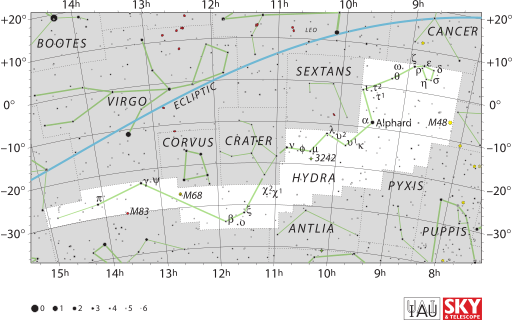
No comments:
Post a Comment